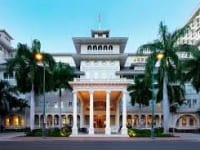
Mauna Kea Beach Hotel
Mauna Kea Beach Hotel

History with a twist of luxury is seductive.
When I think of famous, elegant hotels – the Ritz in Paris, the Plaza in New York and the Pera Palas in Istanbul – come to mind. When I think of Hawaii two historic properties join the club of bejeweled, historic hotels, the Mauna Kea Beach Hotel on Hawai’i Island and the Westin Moana Surfrider in Honolulu.
The Mauna Kea Beach Hotel was created by venture capitalist and passionate conservationist Laurance S. Rockefeller. As a guest of the governor, he visited the Big Island in 1960 looking for the perfect site to develop the first resort on the raw and stunning Kohala Coast. He stopped looking when he dug his toes into the soft sand of a long, crescent beach in Kauna’oa Bay – a place the Travel Channel would on day describe as “America’s No. 1 Beach” and “Number 5 Beach in the World”.

When Rockefeller began planning the hotel he stated “The design should follow the natural contours of the land, incorporate lava rock and in every possible way make the hotel invisible.” He and his architects Skidmore, Owings & Merrill created a clean Mid Century Modern design and carved out an oasis from a hillside of lava rock. The resort incorporates the topography with open-air galleries, hallways, gardens, Koi fish ponds and a blue-tiled lobby that draws your eye to the ocean.

Fifty years ago curators combed the Pacific and Asia for art pieces to decorate the hotel. Imagine the pleasure of walking to the lobby and passing two thousand year-old Buddha statues or hand-stitched Hawaiian quilts. The stellar collection has more than 1,600 pieces, so there’s a surprise around every corner.
Esquire Magazine listed The Mauna Kea Beach Hotel as one of the three greatest hotels in the world in 1967 shortly after it opened in 1965. This year marks its 50th anniversary and it remains a landmark of luxury in Hawaii.
Let’s dine al fresco. With the stars above and the illuminated surf below, the Manta Restaurant earns kudos for creative combination of international cuisine and fresh, local fish. My husband Gary tasted four superb wines with dinner thanks to the high tech, latest development for wine aficionados. The three “Enomatic” machines store 48 superb wines, selected from high-end and the latest stars from various vintners.
Another evening we took the shuttle to the Coast Grille, at the hotel’s sister property, the Hapuna Beach Prince Hotel, to feast on locally sourced Kona Abalone, farm-raised jumbo shrimp, Ono, Mahi Mahi, and seared Ahi with truffle sauce. Chef Vincent Logan, who boasts an impressive pedigree, regaled us with fabulous fish, eight hours out of the water, and tender greens recently picked in the property’s organic garden.
The beach, architecture and art at Mauna Kea Beach Hotel remain timeless a half century after it opened and through numerous multi-million dollar renovations. Its classy clientele, from couples to multi-generational families, return every year.

The spirit of a bygone era in Honolulu
When we arrived at the hotel on Waikiki Beach, the first thing we noticed –before the umbrella in my mai tai, the sun, the white sand beach or the surfers, was the white pillared portico, Victorian architecture and the teak rocking chairs on the wrap-around porch. “I feel like I’ve arrived at a gracious plantation in the Deep South”, I told my husband, Gary. Always the realist, he reminded me of our address on Waikiki’s Luxury Row – the “Rodeo Drive” of Honolulu – where our neighbors were Tiffany & Co., Coach, Gucci, Yves Saint Laurent, and Cannel.
Although Honolulu has changed significantly since the legendary resort on Waikiki Beach opened 114 years ago, the spirit of a bygone era lives on in the Moana Surfrider – a Westin Resort and Spa – known as “The First Lady of Waikiki”.
After a warm Hawaiian greeting from the bellmen, we walked up the grand steps and entered a chandeliered living room with polished hardwood floors. A soft breeze floated in from the open doors that revealed an expanse of white sand beach, an open air restaurant with wooden slat fans overhead and a garden punctuated with a hundred-year Banyon tree.
In 1901 when the hotel opened – the first on Waikiki Beach- a room cost $1.50. The sea voyage between the West Coast of the mainland and Hawaii took five days. Today the trip takes five hours by plane. Male guests could rent a wool bathing suit for bathing. Women, of course, were expected to wear dresses and footwear into the water. Don’t miss the second floor museum filled with photos, historic memorabilia and ancient Hawaiian artifacts. The “First Lady of Waikiki” blends the best of Hawaiian spirit with the Westin service and amenities.